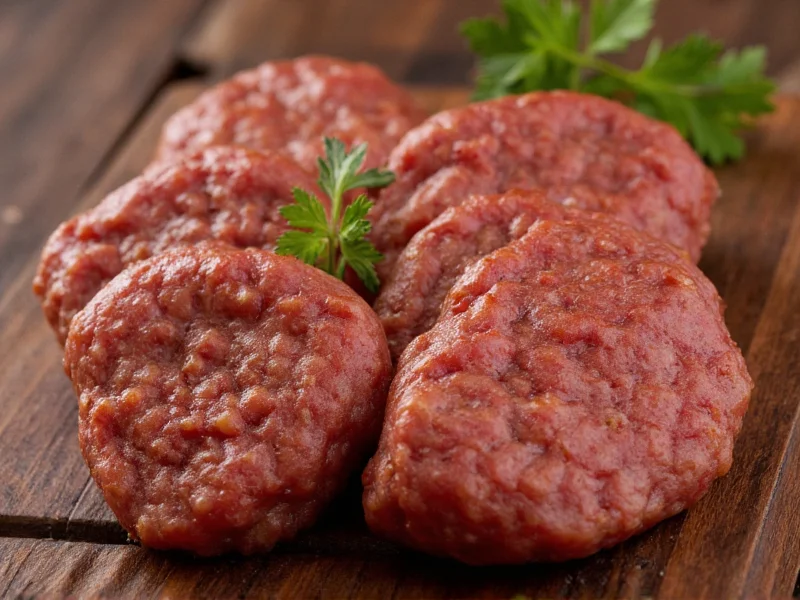Many people searching for "goetta sausage" mistakenly believe it's a type of sausage. This common misconception stems from its meat-based composition and breakfast application. Understanding the true nature of goetta reveals a unique culinary tradition with deep roots in Cincinnati's German immigrant community.
What Exactly Is Goetta?
Goetta (pronounced "get-uh") represents a practical solution developed by 19th century German immigrants in Cincinnati. Facing economic constraints, these settlers combined inexpensive oats with meat trimmings to stretch their food supplies. The resulting mixture, when cooked properly, forms a firm loaf that can be sliced and fried.
The traditional recipe maintains a specific ratio: approximately 70% meat (usually pork, though some variations use beef or a combination) and 30% steel-cut oats, plus onions, broth, and signature spices like thyme, rosemary, and black pepper. This composition fundamentally distinguishes goetta from sausage, which typically contains 60-80% meat with minimal grain content.
| Characteristic | Goetta | Traditional Sausage |
|---|---|---|
| Primary Ingredients | Meat, oats, spices, broth | Meat, fat, spices |
| Meat-to-Grain Ratio | 70% meat, 30% oats | 80-95% meat, minimal grains |
| Form | Loaf (sliced after cooking) | Cased links or patties |
| Cooking Method | Boiled then pan-fried | Grilled, fried, or baked |
| Texture | Firm with grainy consistency | Soft, crumbly when cooked |
The Historical Journey of Goetta
German immigrants introduced goetta to Cincinnati around the 1850s. Originally called "gruetz" or "grutze," this dish provided an economical way to incorporate meat into daily meals. The oats served multiple purposes: they extended the meat, added nutritional value, and helped bind the mixture together.
Cincinnati's meatpacking industry, particularly the presence of major pork processors like Glier's (established 1946), helped cement goetta's place in regional cuisine. While other cities had similar meat-and-grain combinations (like Pennsylvania's scrapple), Cincinnati developed its own distinctive version that became a cultural touchstone.
How Goetta Is Made and Prepared
The preparation process for traditional goetta involves several precise steps:
- Simmering meat trimmings with onions and spices in broth
- Adding steel-cut oats and continuing to cook until the mixture thickens
- Pouring the mixture into loaf pans and refrigerating until firm
- Slicing the chilled loaf into 1/2-inch pieces
- Pan-frying the slices until crispy on both sides
Unlike sausage patties that cook quickly, goetta requires patience. The slices need sufficient time in a hot skillet to develop a crispy exterior while maintaining a tender interior. Many Cincinnati residents consider properly cooked goetta to have a "crust" on both sides with a soft center.
Where to Find Authentic Goetta
While goetta originated in Cincinnati, its availability has expanded beyond Ohio. Major grocery chains in the Midwest often carry it, particularly during breakfast seasons. For those outside this region, specialty food stores or online retailers provide access to authentic Cincinnati-style goetta.
Glier's Goetta remains the most widely distributed commercial brand, available in both meat-only and vegetarian versions. Some craft butchers and specialty food producers have also begun creating their own interpretations, though purists argue that true goetta must maintain the traditional meat-to-oat ratio and preparation method.
Culinary Applications and Modern Variations
While traditionally served as a breakfast item alongside eggs and toast, contemporary chefs have expanded goetta's applications. Creative uses include:
- Goetta breakfast sandwiches with egg and cheese
- Cubed and added to breakfast hashes
- Served as an appetizer with dipping sauces
- Used as a pizza topping
- Incorporated into breakfast burritos
Modern variations sometimes experiment with different meats (like turkey or chicken), alternative grains (such as quinoa), or additional flavorings like jalapeños or applewood smoked ingredients. However, the Cincinnati Chamber of Commerce has established guidelines for authentic "Cincinnati Goetta" that specify the required ingredients and preparation methods.
Cultural Significance in Cincinnati
Goetta has transcended its humble origins to become a symbol of Cincinnati's German heritage. The city celebrates its goetta tradition with an annual Goettafest, featuring cooking competitions, live music, and of course, abundant goetta samples. Local restaurants often feature creative goetta dishes during this celebration.
The dish's importance to Cincinnati culture is such that when the city's NFL team, the Bengals, travels for away games, fans sometimes bring goetta to tailgates as a taste of home. This regional specialty has become part of Cincinnati's identity, distinguishing it from other American cities with their own unique food traditions.
Frequently Asked Questions About Goetta
Is goetta the same as scrapple?
No, goetta and scrapple differ significantly. While both are meat-and-grain breakfast foods, scrapple (from Pennsylvania Dutch tradition) uses cornmeal instead of oats and typically includes more organ meats. Goetta has a smoother texture and milder flavor profile compared to the stronger taste of scrapple.
Can goetta be made vegetarian or vegan?
Yes, vegetarian and vegan versions of goetta exist. These substitutes replace meat with mushrooms, lentils, or textured vegetable protein while maintaining the traditional oat base. Glier's offers a certified vegetarian version that follows the same preparation method but uses plant-based ingredients.
How should I store and reheat goetta?
Uncooked goetta loaf keeps refrigerated for 5-7 days or frozen for up to 3 months. Once cooked, store leftovers in an airtight container in the refrigerator for 3-4 days. The best reheating method is pan-frying in a little oil to restore the crispy exterior. Avoid microwaving, which makes goetta soggy.
Why is goetta associated with Cincinnati specifically?
Cincinnati's large German immigrant population in the 19th century, combined with its status as a major pork processing center (earning the nickname "Porkopolis"), created the perfect conditions for goetta's development and popularity. The city's meatpacking industry provided abundant meat trimmings, while German culinary traditions contributed the technique of combining grains with meat.
What's the proper way to pronounce "goetta"?
The correct pronunciation rhymes with "better" or "letter" (GET-uh). Many non-locals mistakenly say "goat-ta" or "get-ah," but Cincinnati residents consistently use the short "e" sound as in "get."











 浙公网安备
33010002000092号
浙公网安备
33010002000092号 浙B2-20120091-4
浙B2-20120091-4